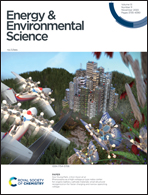A scalable top-down strategy toward practical metrics of Ni–Zn aqueous batteries with total energy densities of 165 W h kg−1 and 506 W h L−1†
Abstract
Research interest in alkaline aqueous batteries has surged worldwide due to their merits of low cost and high safety. However, the development of practical high-energy Ni–Zn batteries has been beset by the bias between industrial application with gravimetrical energy limits and scientific research with volumetrical shortages. Herein, we propose a facile top-down strategy to prepare low-cost and ultra-dense Co-free microscale cathodes for Ni–Zn batteries. Based on the anion exchange and Kirkendall effect, this commercially viable technology is capable of permeating the matrix of microspheres with uniform and robust adherence of NiS nanodots and abundant mesopores. The enhanced proton-diffusion kinetics endows the Ni–Zn battery with impressive areal capacity (41.3 mA h cm−2) and a fast power response of 715 mW cm−2, together with 80 000 transient pulse cycles. A best practice for systematic measuring of aqueous batteries in a more practical metric is proposed. As a proof of concept, we demonstrate a commercial-grade 3.5 A h Ni–Zn pouch battery, which concomitantly presents record-high energy densities of 165 W h kg−1 gravimetrically and 506 W h L−1 volumetrically based on the whole battery. The cost is estimated conservatively at US $32.8 kW h−1 on a device scale. These results provide a new opportunity to advance high-energy Ni–Zn batteries and should be of immediate benefit toward low-cost, practical energy storage and grid-scale applications.

- This article is part of the themed collections: 2023 Journal of Materials Chemistry Lectureship shortlisted candidates and Energy & Environmental Science Cover Art


 Please wait while we load your content...
Please wait while we load your content...